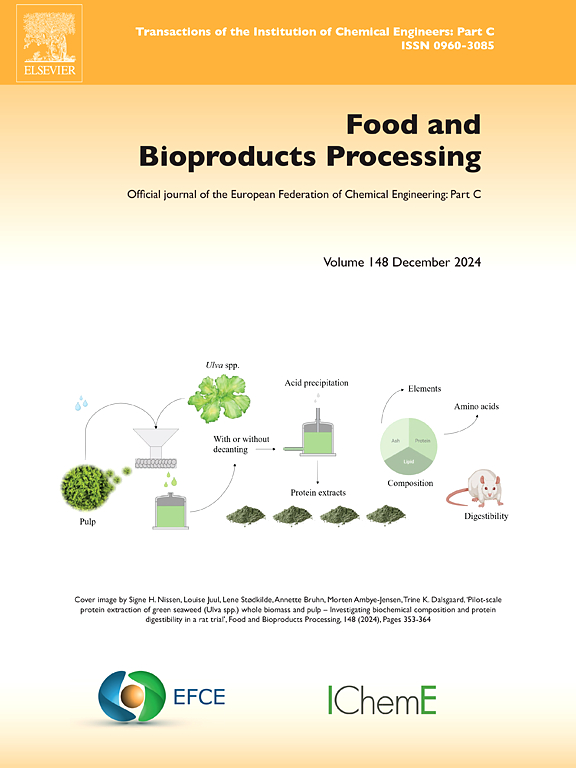金银花提取液真空脉冲红外干燥工艺参数优化:生物活性保持及粉末特性
IF 3.4
2区 农林科学
Q2 BIOTECHNOLOGY & APPLIED MICROBIOLOGY
引用次数: 0
摘要
天然产物通常具有热敏性,现有干燥技术普遍存在热敏性降解严重、能耗高、时间长等问题。在此基础上,本研究建立了真空脉冲红外干燥(VP-IRD)工艺,并将其应用于金银花的干燥。(金银花)提取物。通过系统优化干燥参数(温度70℃,料厚6 mm,辐射距离100 mm,真空时间10 min,大气压时间4 min),绿原酸(86.43 %)、多糖(85.76 %)和黄酮类化合物(87.17 %)的保留率较高。与热风干燥(HAD)和喷雾干燥(SD)相比,这些速率增加了9 %-12 %,而消耗的能量比冷冻干燥(FD)少75.73 %。VP-IRD热力学相关分析显示,颜色参数L*与活性组分保留率呈强正相关(r >; 0.78),a*与美拉德反应呈负相关(r = -0.63),证实L*是干燥过程中组分降解的敏感指标。对干粉物性参数的分析表明,vp - ird处理后的粉体具有最佳的粒度分布,粉体流动性和堆积密度显著提高,具有优于HAD和SD的物理特性。本研究通过多尺度分析框架(活性成分-热力学相关性-粉体性质)阐明了VP-IRD的协同作用机制,为协同保护活性成分的中草药提取物的工业干燥提供了高效、低能耗的解决方案。本文章由计算机程序翻译,如有差异,请以英文原文为准。
Parameter optimization of vacuum pulsed-infrared drying for honeysuckle extract: Bioactive retention and powder properties
Natural products are usually heat-sensitive, and the existing drying techniques generally have problems such as severe heat-sensitive degradation, high energy consumption and long time. On this basis, this study established the vacuum pulsed infrared drying (VP-IRD) technology for extracts and applied it to the drying of Lonicera japonica Thunb. (honeysuckle) extracts for the first time. Through systematic optimization of drying parameters (temperature 70°C, material thickness 6 mm, radiation distance 100 mm, vacuum time 10 min, atmospheric pressure time 4 min), high retention rates were achieved for chlorogenic acid (86.43 %), polysaccharides (85.76 %), and flavonoids (87.17 %). These rates represented a 9 %-12 % increase compared to hot air drying (HAD) and spray drying (SD), while consuming 75.73 % less energy than freeze drying (FD). Thermodynamic correlation analysis of VP-IRD revealed a strong positive correlation (r > 0.78) between the color parameter L* and the retention rate of active components, and a negative correlation (r = -0.63) between a* and the Maillard reaction, confirming L* as a sensitive indicator of component degradation during drying. Analysis of the physical parameters of the dried powder demonstrated that VP-IRD-treated powder possessed the optimal particle size distribution, significantly improved powder flowability and bulk density, and exhibited superior physical characteristics compared to HAD and SD. This study elucidated the synergistic mechanism of VP-IRD through a multi-scale analysis framework (active components - thermodynamic correlations - powder properties), providing an efficient, low-energy-consumption solution for the industrial drying of Chinese herbal medicine extracts that synergistically protects active components.
求助全文
通过发布文献求助,成功后即可免费获取论文全文。
去求助
来源期刊

Food and Bioproducts Processing
工程技术-工程:化工
CiteScore
9.70
自引率
4.30%
发文量
115
审稿时长
24 days
期刊介绍:
Official Journal of the European Federation of Chemical Engineering:
Part C
FBP aims to be the principal international journal for publication of high quality, original papers in the branches of engineering and science dedicated to the safe processing of biological products. It is the only journal to exploit the synergy between biotechnology, bioprocessing and food engineering.
Papers showing how research results can be used in engineering design, and accounts of experimental or theoretical research work bringing new perspectives to established principles, highlighting unsolved problems or indicating directions for future research, are particularly welcome. Contributions that deal with new developments in equipment or processes and that can be given quantitative expression are encouraged. The journal is especially interested in papers that extend the boundaries of food and bioproducts processing.
The journal has a strong emphasis on the interface between engineering and food or bioproducts. Papers that are not likely to be published are those:
• Primarily concerned with food formulation
• That use experimental design techniques to obtain response surfaces but gain little insight from them
• That are empirical and ignore established mechanistic models, e.g., empirical drying curves
• That are primarily concerned about sensory evaluation and colour
• Concern the extraction, encapsulation and/or antioxidant activity of a specific biological material without providing insight that could be applied to a similar but different material,
• Containing only chemical analyses of biological materials.
 求助内容:
求助内容: 应助结果提醒方式:
应助结果提醒方式:


